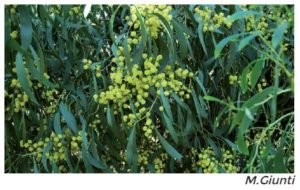 Common name: Mimosa
Common name: Mimosa
Scientific name: Acacia sp. pl.
Brief description: In the Tuscan Archipelago there are 3 invasive species of acacia (mimosa) which are mainly differentiated by the shape of the leaves. The flowers are very similar, spherical and a very bright yellow.
Acacia dealbata is the classic mimosa, symbol of International Women’s Day (8th March). It can reach up to 15m in height.
Acacia pycnantha differs from A. dealbata due to its long, sickle-shaped leaves. The size of the plant is in fact smaller (6-8 metres in height). Acacia saligna is a small plant with dense foliage and “weeping” branches.
Biology and ecology: Acacias prefer to grow in areas with a temperate climate, fearing very cold winters. In optimal conditions they give rise to dense formations and tend to colonise bare ground rapidly. After a cut to the trunk the acacias react by emitting new shoots from both the stump and the roots.
Distribution in the Tuscan Archipelago and introduction: Introduced in Europe around the mid 800s, in the Tuscan Archipelago mimosas are present in Elba, Giglio and Capraia. As for the other two species of mimosa, the Acacia saligna was also introduced for ornamental purposes, but more than the other two it found use in forestation operations beginning in the ‘60s in many coastal areas of Italy, both sandy and rocky, showing great vegetative and propagation capabilities.
Impact: Outside of the distribution area of origin, the species of the Acacia genus are a serious threat for biodiversity. On the Island of Elba, A. dealbata is that which shows the broadest and most intense diffusion processes, followed by A. saligna. In invaded areas, this species forms dense populations which compete with native vegetation and may increase the risk of fire.
Management in protected areas: With the “Montecristo 2010” project the species was eliminated from Pianosa.




